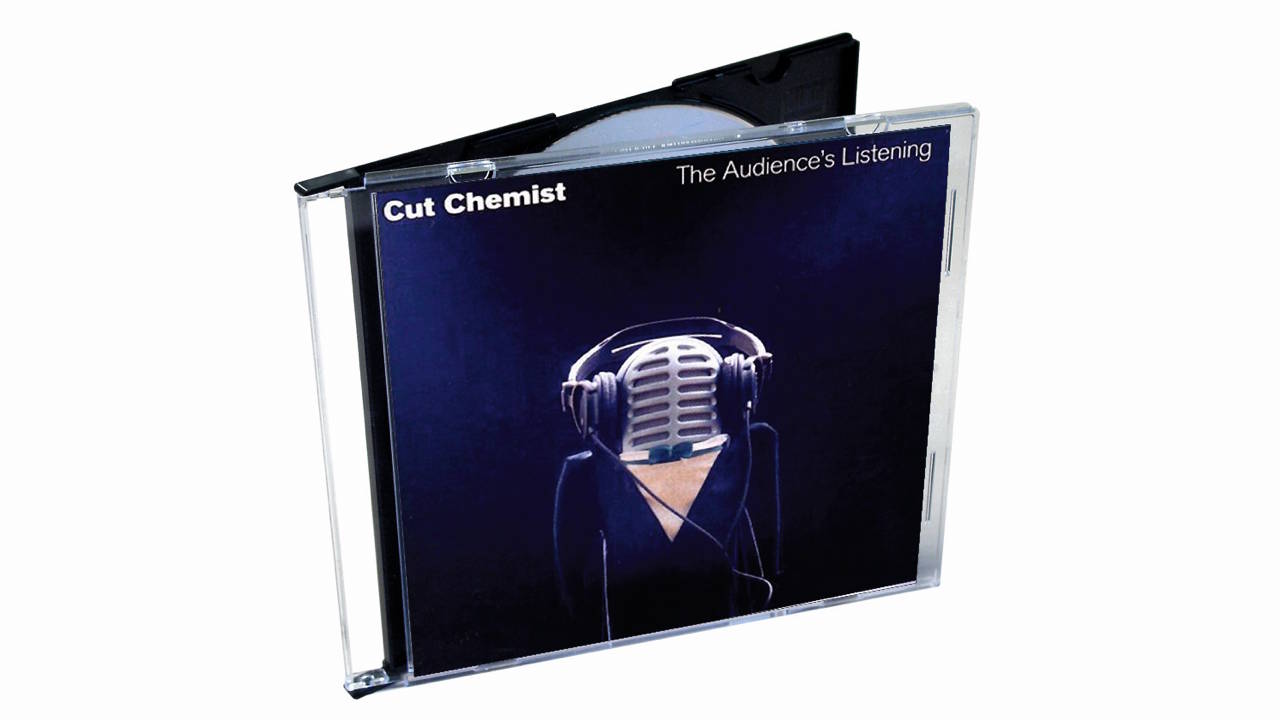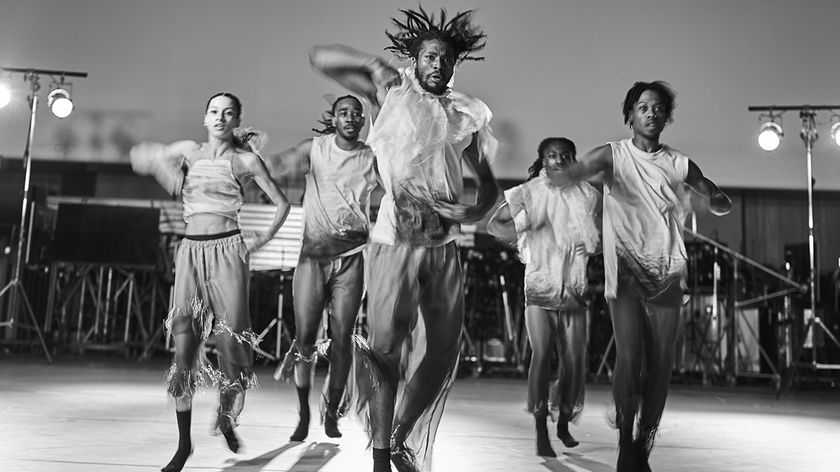Classic album: Cut Chemist on The Audience’s Listening
Over 12 tracks, The Audience’s Listening took you further than Cut Chemist ever had before

When it came time for Cut Chemist’s first full-length solo album he knew he wanted to push himself, and the boundaries of his craft of sample-based music. Quite the task, considering the height he’d already set the bar at with tracks like the cut ‘n’ paste masterpiece Lesson 6, and the catalogue of funky beats he’d gifted his Rap crew, Jurassic 5.
To clear his mind before the big push, he assembled every loose loop, nagging sample, and chopped-up beat he’d been toying with up to that point and created the epic mixtape, The Litmus Test, as a way of purging old ideas.
“It helped me clear my desktop of half-finished things and older projects, and it let me know where I’d been and where I wanted to go from here,” says Cut.
“I spent a year making that, but it gave me a fresh start for my album."
That album was The Audience’s Listening, and over its 12 track running time it takes you further than Cut Chemist ever has before on wax. Armed with an MPC, Pro Tools, and a stack of plundered vinyl, he whipped up a creative riot of samples, funky rhythms, playful scratches, and surprising twists and turns around a world of musical influences. Tracks like The Garden grow from the seeds of some luscious Bossa and Samba samples, while (My 1st) Big Break channels the start of Pulp Fiction with its dialogue set-up and epic Surf Rock attitude.
Spat, on the other hand, transforms the scribbles of scratching into the escalating sounds of an argument between two very odd characters. And A Peak In Time uses the ingenious move of pitching up variations of the same female vocal sample on top of one another in different octaves to create the illusion of a multi-voice choir. It’s a joy from start to finish, and a peek into a time where man and sampling machine are in perfect harmony.
“This was my first solo album so I put a lot of pressure on myself and built on what I’d done before,” Cut says. “I just wanted to elevate my craft.” Job done.
Get the MusicRadar Newsletter
Want all the hottest music and gear news, reviews, deals, features and more, direct to your inbox? Sign up here.
Here, he takes us through The Audience's Listening, track by track.

Motivational Speaker
“I wanted to start off with something familiar, so people wouldn’t think I’d abandoned my old ways. I wanted to add all the elements that people know me for: cuts, a weird sample that no one else would ever use, and a concept. The concept was ‘What is the DJ of today?’. That’s the time in the mid-2000s when the Hip-Hop DJ was becoming extinct. I felt a void of turntablism for the first half of that decade. I didn’t know where it was going so I made this song about the DJ of the future.”
(My 1st) Big Break
“It started off as a song about digging for records. It was gonna feature interviews with DJs I respected about the first big break that they’d found. It was an idea I’d had for a few years. I’d already gotten a coupla interviews with Shadow and people like that.
“But then I found the break that we know as the break on this record. I think it’s off an English record. Then I found an old sermon record that said, ‘The robots are coming…’ I just happened to play it with that new beat and a light went on.
“I scrapped the whole digging thing and said, ‘Let’s make (My 1st) Big Break a completely different trip. Let’s make it a Science Fiction Surf Rockabilly song. Fuck it.’”
The Lift
“I needed a comedown after the first two tracks as there was so much information, so much movement, so much energy. I’d found this record called Thoughts In Time. It was a US Library record. I liked the samples, they were very New Age. Then I added some samples I’d taken with a portable recorder of the announcer in an elevator when I was on tour with Jurassic 5. The woman who says things like, ‘Going up’. That’s where the name The Lift comes from. The concept was this track would lift you to somewhere else.”
The Garden
“Tracks like Runnin’ by The Pharcyde inspired me to dig out Brazilian samples. I was taking a Music of Brazil class at UCLA as well. I wanted to further this journey into Brazil so I started to mess with Berimbau by Astrud Gilberto over some beats and it worked. I begged Warner Bros to clear the original sample. They did, then I took the final composition down to Brazil and found a Samba band and recorded them in a studio in Sao Paulo. Then I brought it to my engineer, Kent Hitchcock, who mixed it to perfection.”
Spat
“It’s a phone argument between two scratched-up voices. Kid Koala’s Fender Bender was a huge influence, which has almost the same idea of people arguing through scratches.
“I spent a lot of time trying to figure out how to EQ this to differentiate one guy from the next. I ended up having one sound like he was coming through the receiver, versus one in the room, over an unassuming loop from a Jazz record. I wanted it to convey emotion. You can hear when the characters are remorseful, when they are apologising, when they are bickering. The last part has them in harmony, like they are friends again.”
I did background vocals. It was the first time I’d ever grabbed a mic.
What’s The Altitude
“This song features the rapper Hymnal who is my best friend. I’ve known him since I was 12. I knew I wanted this album to feature my friends. I didn’t want it to feature people I didn’t know, just to sell records, or look cool.
“I gave him this beat. It was unlike anything I’d ever done before. I didn’t know if I liked it, which made me like it. He did his verses over that. It became even weirder. It was sexy, kinda Indie Rock. It had an Ethiopian chord progression to it. The rap was sexy, about a girl.
“I did background vocals. It was the first time I’d ever grabbed a mic.”
Metrorail Thru Space
“In 2005 I befriended the singer, Jem. She moved out to California and reached out to me to do a remix for her song They. I did, and later we were chatting and I played her what I had for a track I was working on called Metrorail Thru Space. It needed something and she suggested using the drum track from the remix to They. I went home and tried it and was like, ‘Holy fuck! She’s right’. She totally told me what to do like, ‘You need to put that shit on that shit!’ [laughs]. Anybody that wants to train-spot this track down can go listen to the They remix. Right down to all the changes and everything.”

Storm
“This features Edan and Mr. Lif. This was a totally different track to start with, but once they got on it I ended up flipping it. The original version of Storm can be found on my ten year anniversary Audience’s Following album, which I put out this year. It’s called Siesta. Basically it’s the original beats I gave them to rap over, which was a real chunky, tough as nails drum break.
“The same time I was making this beat I was making my Torture Chamber remix for Edan. By that point I’d had my fill of chunky drum break sample stuff.
“I’d found a record in Italy that was a French compilation of Post-Punk that featured a track called Megamix by a group called Vox Populi! It blew my mind. It was the sound I wanted. It sounded like a Psychedelic version of what’s happening today, so I used that as inspiration.”
2266 Cambridge
“Warner Bros wanted me to change the name because it’s an actual address, but the title had everything to do with the song. I had this record that was recorded in this house. It was in the mid city district of LA, and was two houses down from Thes One from [Rap group] People Under The Stairs.
“I hooked up with him and we jumped in his ride and rode around that block, recording stuff along the way of people chilling and having BBQs. Then I said, ‘Let’s see what’s going on at that actual house’.
“I sampled stuff all around there and it made a cool little vibe, and was a nice comedown track. It’s like a nice slice of LA life. No drive-bys, no drama. Just people having a good time on a Sunday.”
Spoon
“The big sample is from a Polish crew called Breakout. It was just one of those records. You couldn’t deny its grooves. I had to be very cunning about sampling around the vocals to get a seamless loop, as there were no clean, open parts of it. There was this one bit of singing that I couldn’t get out of the sample where he sounds like he’s singing ‘Spoon’, but I don’t know what he’s saying. It’s in Polish. I couldn’t get out of it so just made it part of the song.
“The live stuff comes from Miles Tackett from Breakestra who plays guitar. Then David Stromberg is playing an instrument called the tres, which is a Cuban three-string guitar. And my engineer, Kent Hitchcock, plays bass.”
A Peak In Time
“This was a song originally done for the Keepintime album, as Peek In Time. Keepintime was a meeting of old-school drummers and new-school producers. I wanted to update it.
“The main loop is a Gilberto Gil sample, but one that I sampled off [fellow Jurassic 5 member] Nu-Mark, who had it loaded into an MPC and was noodling around with it at a Keepintime live show. He was playing all different patterns but he caught one that ended up being my main loop. To finish it off I added an Australian break, and did my ‘Samba Scratch’, where I take voices and do harmony cuts, layering scratched-up patterns of singers on top of each other in different pitches.”
After the album dropped Apple got in touch about using it for a global iPod advert. But The Boogie Boys was the only sample I hadn’t cleared, as I thought it was such a small part. I had to tell Warner Bros and try to clear it. It was a huge campaign and we needed to clear this thing in a coupla hours.
The Audience is Listening Theme Song
“It has a sample from [Old School Rap pioneers] The Boogie Boys going, ‘Listen, listen to the music…’ After the album dropped Apple got in touch about using it for a global iPod advert. But The Boogie Boys was the only sample I hadn’t cleared, as I thought it was such a small part. I had to tell Warner Bros and try to clear it. It was a huge campaign and we needed to clear this thing in a coupla hours. My manager in New York had to go to the guys’ house and they wouldn’t open the door for less than $30,000, which was my whole fee. I said, ‘Just fucking do it. Make the deal.’ He slid the contract under the door, and they signed and slid it back. The ad aired the next day [laughs].”
For a whole crazy batch of new and previously unreleased digital material head to https://cutchemist.bandcamp.com


Computer Music magazine is the world’s best selling publication dedicated solely to making great music with your Mac or PC computer. Each issue it brings its lucky readers the best in cutting-edge tutorials, need-to-know, expert software reviews and even all the tools you actually need to make great music today, courtesy of our legendary CM Plugin Suite.

"Reggae is more freeform than the blues. But more important, reggae is for everyone": Bob Marley and the Wailers' Catch a Fire, track-by-track

“Part of a beautiful American tradition”: A music theory expert explains the country roots of Beyoncé’s Texas Hold ‘Em, and why it also owes a debt to the blues











